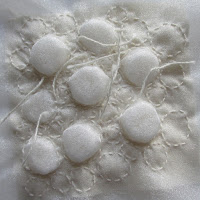Wadded Quilting
So these first three samples are by way of "getting my eye in". I've based the designs inevitably on my field.
The first uses a calico backing, lawn to and man-made padding, with running stitch to quilt the layers. It's very straight forward and effective.
 |
5:1
|
The two images below show both sides of a quilting sandwich which uses scoured cotton and scrim with the same man-made padding. The running stitch shows the tree outline clearly on the scoured scrim, less so on the scrim where the stitching has pulled through the very lose weave.
 |
| 5:2 |
 |
| 5:3 |
Now for some more adventurous combinations:
Firstly, two versions using calico and netting with paper shreddings in between.
In 5:4 I used double lines of running stitch, which were very challenging to achieve and no where near as effective as the fly stitch on 5:5. One point of difference between the two samples was the more careful sorting of the coloured shreddings. Secondly, fly stitch seems a much better echo of the jumbled small strips of paper, though the sheen on the thread maybe works less well. Net really is an ideal fabric for showcasing both stitch and stuffing.
 |
| 5:4 |
 |
| 5:5 |
The next sample shows the same fabric combination, but with elongated curls of wood shavings. Large, irregularly sized cross stitches in a wiry jute are used to hold the sandwich together. A thicker fibre thread might be more obvious, but I do like the way it's visible at one moment, disappearing between the curves of the shavings the next.
 |
| 5:6 |
 |
| 5:7 |
In the second version jute knots have been used to secure the layers. Again, the string used to tie the layers doesn't make the knots fully visible: the string's too thin and its tone too close to that of the shavings. It's a question of finding something that will fit through a needle. A solution for thicker string would be to use an empty needle to make a hole and push the string through -- fine for making knots, but not for an embroidery stitch.
Thinking about the hedgerow I've been studying, so much in nature has tones that are very similar, so maybe I'm being over critical.
And next, calico, two-way stretch fabric (white tights) and wood shreddings ( another challenging padding) with lines of fly stitch.
What is particularly interesting about combining the two fabrics is that by pulling the stretch fabric quite tightly a curve can be created. I can see how interesting this can be, especially if a number of such pieces are attached to each other.
 |
| 5:8 |
Then finally in this group 5:8, a calico, scrim and sawdust combination with lines of double crosses.
This really was a very impractical combination with the sawdust escaping its sandwich and failing to remain in place once stitched. However, I do like that impression of something newly excavated!
 |
| 5:9 |

































